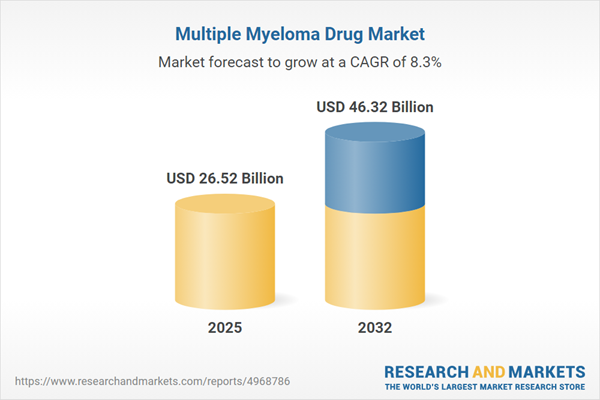Speak directly to the analyst to clarify any post sales queries you may have.
The multiple myeloma drug market presents fast-evolving opportunities and operational challenges for industry leaders, shaped by continuous innovation, regulatory demands, and advanced analytics. Senior executives must strategically position their organizations to capture value in this shifting environment, leveraging an integrated, data-driven approach.
Market Snapshot: Multiple Myeloma Drug Market Growth Outlook
As of 2024, the global multiple myeloma drug market is valued at USD 24.51 billion, reflecting robust momentum and a compound annual growth rate (CAGR) of 8.27%. This positive trajectory is driven by increasing adoption of immunomodulatory agents, technological advancements in monoclonal antibody therapies, and further uptake of innovative proteasome inhibitors. Pharmaceutical organizations are focusing on comprehensive R&D initiatives and real-world evidence collection, proactively aligning new product pipelines with changing clinical requirements and regulatory frameworks. Strategic adaptability is becoming essential to outperform competitors in a dynamic landscape where guidelines and access pathways are frequently updated.
Scope & Segmentation of the Multiple Myeloma Drug Market
- Drug Classes: Includes histone deacetylase inhibitors, immunomodulatory agents, monoclonal antibodies, and proteasome inhibitors, each addressing distinct molecular mechanisms and enabling diversity in therapeutic approaches.
- Treatment Regimens: Options incorporate single-agent, doublet, triplet, and quadruplet regimens, equipping clinicians to personalize therapies as standards of care evolve and as new combinations achieve regulatory acceptance.
- Lines of Therapy: Segmentation covers first-line, second-line, and advanced therapies, assisting organizations in tailoring strategies for broadened clinical reach and refined market positioning.
- Administration Routes: Delivery methods—intravenous, oral, and subcutaneous—enhance flexibility in various care settings, increasing patient access and supporting adherence in both inpatient and outpatient workflows.
- Patient Demographics: Stratification by age and gender informs development of targeted interventions, advancing precision medicine and ensuring therapies meet a wide spectrum of unmet clinical needs.
- Distribution Channels: Comprises hospital networks, retail pharmacies, and online platforms, improving both conventional and remote therapy access while optimizing distribution efficiency and supply chain performance.
- Geographic Coverage: Analysis spans North America, South America, Europe, Middle East & Africa, and Asia-Pacific, acknowledging distinct regulatory systems, reimbursement landscapes, and region-specific barriers to entry and commercialization.
- Key Companies Analyzed: Benchmarking covers Bristol-Myers Squibb, Janssen Biotech, Takeda, Amgen, Novartis, AbbVie, Sanofi, GlaxoSmithKline, Karyopharm Therapeutics, and Teva, with comparative insight into innovation priorities and go-to-market models.
Key Takeaways for Senior Decision-Makers
- Portfolio management tools enable leadership to reprioritize R&D investments, ensuring resource allocation remains aligned with scientific advances and evolving compliance standards.
- Integration of advanced analytics and digital health platforms supports rapid adaptation to incoming clinical data, driving higher levels of care coordination and stakeholder engagement.
- The use of molecular and cytogenetic profiling expands patient segmentation strategies, facilitating the shift towards customized therapies while supporting adoption of value-based care frameworks for enduring relevance.
- Strategic partnerships and licensing agreements accelerate the introduction of innovative compounds, bolstering organizational competitiveness across established and growth markets.
- Deployment of digital pharmacy infrastructure broadens therapy reach, enhances operational forecasting, and delivers actionable insights for supply and demand management.
- Forward-thinking approaches to monitoring reimbursement landscape changes and managing emerging market risks help preserve organizational stability amid ongoing sector transformation.
Tariff Impact: Navigating Regulatory and Supply Chain Pressures
Recent changes in United States tariff policy have heightened supply chain complexities, especially regarding procurement of proteasome inhibitors and epigenetic-based therapies. Market leaders are implementing near-shoring strategies and agile procurement models to fortify supply network resilience. Enhancing supplier relationships and securing distribution routes are now central measures for stabilizing market presence and controlling product cost volatility.
Methodology & Data Sources
The analysis draws on extensive secondary research from leading regulatory, scientific, and clinical resources, augmented by interviews with oncologists, pharmacy executives, and payers. This combined methodology elevates data accuracy and supports decision-making with industry-validated insight.
Why This Report Matters
- Enables executive teams to anticipate shifts in therapeutics and technology, creating the foundation for strategic action in the multiple myeloma drug market.
- Strengthens cross-functional alignment between regulatory, operational, and commercial priorities, essential for maintaining resilience in an evolving marketplace.
- Provides actionable, evidence-based frameworks that inform investment, partnership evaluation, and improved risk management as treatment and payer dynamics shift.
Conclusion
Resilient operations, evidence-driven planning, and proactive monitoring of market trends are essential for organizations seeking sustained growth and strategic advantage in the coming years of the multiple myeloma drug market.
Additional Product Information:
- Purchase of this report includes 1 year online access with quarterly updates.
- This report can be updated on request. Please contact our Customer Experience team using the Ask a Question widget on our website.
Table of Contents
3. Executive Summary
4. Market Overview
7. Cumulative Impact of Artificial Intelligence 2025
Companies Mentioned
The companies profiled in this Multiple Myeloma Drug market report include:- Bristol-Myers Squibb Company
- Janssen Biotech, Inc.
- Takeda Pharmaceutical Company Limited
- Amgen Inc.
- Novartis International AG
- AbbVie Inc.
- Sanofi S.A.
- GlaxoSmithKline PLC
- Karyopharm Therapeutics Inc.
- Teva Pharmaceutical Industries Ltd.
Table Information
| Report Attribute | Details |
|---|---|
| No. of Pages | 189 |
| Published | November 2025 |
| Forecast Period | 2025 - 2032 |
| Estimated Market Value ( USD | $ 26.52 Billion |
| Forecasted Market Value ( USD | $ 46.32 Billion |
| Compound Annual Growth Rate | 8.2% |
| Regions Covered | Global |
| No. of Companies Mentioned | 11 |









